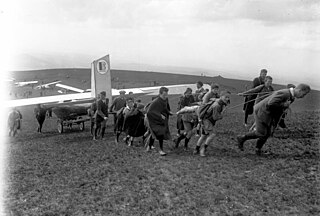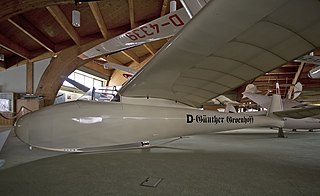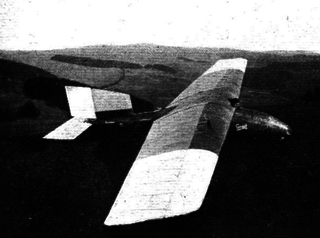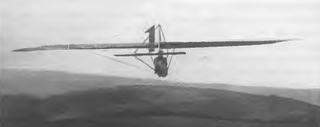Related Research Articles
The Akaflieg Stuttgart fs18a was a glider designed and built in Germany from 1938. It was characterized by a gull wing and was the first glider to have a retractable undercarriage. Only one example of the design was constructed.
Akaflieg Darmstadt is one of approximately twenty aviation groups attached to German universities. Akaflieg is an abbreviation for Akademische Fliegergruppe, an academic group of students and faculty from a German University.
The Sayers S.C.W. was a single seat monoplane glider, designed specifically for the first British gliding competition held at Itford Hill in 1922, an endurance event. Unresolved control problems stopped it from making any competitive flights, but it flew successfully later in the year. It was destroyed on the ground by a storm in December 1922.
The Peyret Tandem or Peyret Alérion, was a French single seat glider of tandem wing configuration. It won first prize at the first British Glider Competition of 1922.

The Hannover H.1 Vampyr was a German glider designed by Georg Madelung for the 1921 Rhön gliding competition, which was held at the Wasserkuppe from 8 August to 25 August 1921. The Vampyr is believed to be the first heavier than air aircraft to use stressed skin. Several historical societies have argued that the aircraft is the precursor of all modern sailplanes.
The Akaflieg Darmstadt D-6 Geheimrat, often shortened to Darmstadt D-6 Geheimrat, was an early competition glider with a single seat and high cantilever wing, designed and built by German University students in 1922.

The Akaflieg Darmstadt D-7 Margarete, often shortened to Darmstadt D-7 Margarete, was one of the earliest two seat monoplane gliders, designed and built by German university students in 1923.

The Akaflieg Darmstadt D-9 Konsul, often shortened to Darmstadt D-9 Konsul, was a high performance, single seat, cantilever monoplane sailplane, designed and built by a German University student group in 1923 for hill soaring.
The Akaflieg Darmstadt D-17 Darmstadt, also called the Darmstadt D-17 and Darmstadt I, was a high performance, single seat, cantilever monoplane sailplane, designed and built by a German University student design group in 1927. It was followed in 1928 by the Akaflieg Darmstadt D-19 Darmstadt 2, a similar aircraft with a new profile, longer span wing.

The DFS Reiher was a single seat competition glider designed in Germany by Hans Jacobs and first flown in 1937. The type won the last two German Rhön gliding championships before the start of World War II. Six were factory produced.

The Schleicher Rhönadler, DFS Rhönadler or Jacobs Rhönadler is a high performance, single seat competition sailplane built in Germany in the 1930s. More than 65 were built.

The RRG Fafnir, named after the legendary dragon, was a single seat German high performance glider designed by Alexander Lippisch. It won the Rhön competition in 1931 and made several outstanding flights as well as setting a fashion for gull wings.
The RRG Professor was a very early soaring glider and the first to use a variometer for finding thermals. It was designed by Alexander Lippisch in Germany, first flying in 1928. The Professor was widely built by both flying clubs and factories.

The Der Dessauer, later Der alte Dessauer, was a German single-seat glider built in the early 1920s. It took part in all the Rhön gliding contests on the Wasserkuppe between 1923 and 1928, flew in the Alps, and made a long-duration flight along the German sea shore.

The BSV Luftikus was a German competition glider, designed for economy of construction and first flown in 1929. From 1929 to 1931 it took part in the annual national gliding contests held on the Wasserkuppe, often known as the Rhön contests.

The F.V.D. Stehaufchen or Der Dresdener Stehaufchen, later relabelled the Akaflieg Dresden D-B1 Stehaufchen, was an unequal span biplane glider designed and built in Germany in 1921. It flew with some success at the second and third Rhön competitions on the Wasserkuppe and was also used to train pilots.

The Akaflieg Hannover H.2 Greif was a 1922 development of the successful Vampyr glider. Though it flew in three successive Rhön (Wasserkuppe) contests, it failed to match the achievements of its predecessor.

The Sb.1 Münchener Eindecker, Loessl Sb.1 Münchener Eindecker,, was a high-wing single-seat glider with an unusual method of pitch and roll control. It won prizes at the second Rhön competition held on the Wasserkuppe in 1921.

The Tułacz M.1 was a Polish glider which competed in the First Polish Glider Contest in 1923. It had some advanced features but its unconventional control system may have caused the landing accident at the end of its first and only flight.

The PWS-101 was a high performance Polish glider first flown in 1937. One made the longest distance glider flight in Europe in 1938, gathering prizes for aircraft and pilot.
References
- 1 2 3 4 5 6 7 8 Kens, Karlheinz (2011). Historische Deutsche Flugzeuge bis 1945 Band 1 [Historic German Aircraft before 1945] (in German). Baden-Baden: Modellsport Verlag GmbH. pp. 64–7. ISBN 978-3-923142-39-2.
- 1 2 3 "German gliders". Flight . Vol. XIV, no. 38. 21 September 1922. pp. 546–9.
- ↑ K. D. Jones, C. M. Dohring, and M. F. Platzer. "Experimental and Computational Investigation of the Knoller-Betz Effect", AIAA Journal, Vol. 36, No. 7 (1998), pp. 1240-1246.
- ↑ Kens (2011). Historische Deutsche Flugzeuge bis 1945. pp. 121–5.